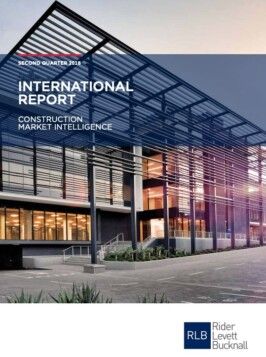The Rider Levett Bucknall (RLB) 2nd Quarter 2018 International Report showcases the positive global sentiment across the construction sector as a whole.
Observations from RLB offices show more than 75% of all global sectors are in the mid or peak zones of the RLB Market Activity Cycle, highlighting the strengthening of most regions’ growing economic output.
Since 2016, RLB has seen a general easing of pressure on increasing building costs across the globe. Countries that experienced construction cost deflation during 2016 are stabilising and forecasting positive growth in construction costs in 2018. Abu Dhabi, Beijing, Chengdu and Singapore are all forecasting positive escalation for 2018.
Australia
The RLB Market Sector Activity Model across Australia showed market activity for Australia was strong for this edition, with 41% of RLB offices reporting sectors in the peak zone, up from 38% in the previous RLB report.
There is a large pipeline of public infrastructure work as conditions in some parts of the private sector support GDP growth.
Matthew Harris, Managing Director of RLB in NSW said, ‘At the present time, Sydney has 13 major projects located in the CBD and surrounding area that have commenced construction or are imminent. Another 17 projects covering the residential, commercial and government sectors are in the planning stage and programmed to start in late 2018/2019.’
Major expenditure on schools to start
‘The NSW Government has commenced a program of major expenditure on government schools throughout the state, providing numerous opportunities for medium sized contractors. A significant increase in enquiries for new aged care projects has been seen during 2018, however, conversion from initial planning to construction continues to be a lengthy process. Delays of up to six (6) months are not uncommon,’ he added.
Buoyant conditions expected for Sydney in 2018
High levels of construction activity is forecast for the Sydney market. Non-residential projects being undertaken by medium sized contractors have had significant pricing pressures due to new enterprise bargaining agreements being above cost expectations. Particular trades have struggled to service existing projects due to lack of experienced personnel. Throughout 2018 industry is expecting buoyant conditions, construction costs are expected to increase primarily driven by increased wage costs rather than material supply costs.’
Matthew continued, ‘Surprisingly, contractor margins should remain constant even with the volumes of work available to tender. Careful consideration as to the timing of bringing projects to the market will be critical to avoid demand price rises and the minimisation of inflated risk allowances being incorporated into project pricing.’
Melbourne building approvals driven by population growth
According to RLB’s International Report, Melbourne is anticipated to have similar steady growth to that experienced in the last 2 to 3 years. Although building approvals are lower than the peak of 2016, they are still at levels exceeding the last 10-year average. Namely driven by Melbourne’s population growth, which in the short term does not seem to be slowing.
Ewen McDonald, Director of RLB in Victoria commented, ‘Population growth and the upcoming state election will see further momentum in infrastructure and social spending (health, education) by the government. Recently commenced projects within Melbourne include: 447 Collins Street, 80 Collins, Melbourne Quarter, Metro Rail and the Western Distributor.’
Softening of apartment sector
‘Within certain sectors (civil and commercial), pricing pressures may see higher rates of escalation than our general published rate due to the number of large scale projects coming into the market. Over the entire market however, a softening in the high-rise apartment sector should offset these sector increases,’ he added.
Perth market to remain unchanged
The RLB report stated that Perth’s construction market is anticipated to remain fairly unchanged over the next six (6) months with no significant changes to the current supply/demand status. There are some signs that the second half of 2018 will see slightly higher construction volume on the back of some confidence returning to the market.
Darwin defence projects to stimulate economy
Darwin’s market is very soft with spare capacity at all levels of the industry. With a number of projects in the planning phase and the need for the government to stimulate the economy we expect the private sector to respond actively once these government projects come on line thereby causing prices to start trending upwards. This will continue as defence projects come on line.
RLB Tender Price Index
Most RLB offices forecast escalation for 2018 to be above the expected inflation rate. Sydney and Canberra’s forecasts show 2018 having the highest rate at 4.9% and 3.5% respectively.
Currently for 2018, RLB is forecasting construction cost growth of 3.5% in Adelaide, 4.0% in Brisbane, 3.5% in Canberra, 0.8% in Darwin, 2.5% in the Gold Coast, 3.3% in Melbourne, 1.1% in Perth and 4.9% in Sydney.
Download PDF: RLB Global Construction Market Intelligence Report Q2 2018
FURTHER INFORMATION:



